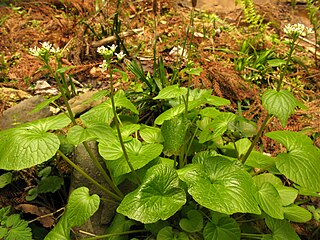Related Research Articles

Wasabi or Japanese horseradish is a plant of the family Brassicaceae, which also includes horseradish and mustard in other genera. A paste made from its ground rhizomes is used as a pungent condiment for sushi and other foods. It is similar in taste to hot mustard or horseradish rather than chili peppers in that it stimulates the nose more than the tongue. Most wasabi flavoring in commerce is, however, ersatz, based on horseradish and food coloring.

Cryptomeria is a monotypic genus of conifer in the cypress family Cupressaceae, formerly belonging to the family Taxodiaceae. It includes only one species, Cryptomeria japonica. It used to be considered by some to be endemic to Japan, where it is known as Sugi. The tree is called Japanese cedar or Japanese redwood in English.

The loquat — Eriobotrya japonica — is a large evergreen shrub or tree, grown commercially for its orange fruit, its leaves for tea, and also cultivated as an ornamental plant.

Oryza sativa, commonly known as Asian rice, is the plant species most commonly referred to in English as rice. Oryza sativa is a grass with a genome consisting of 430Mb across 12 chromosomes. It is renowned for being easy to genetically modify and is a model organism for cereal biology.

Camellia japonica, known as common camellia, Japanese camellia, or tsubaki in Japanese, is one of the best known species of the genus Camellia. Sometimes called the rose of winter, it belongs to the family Theaceae. It is the official state flower of the US state of Alabama. There are thousands of cultivars of C. japonica in cultivation, with many colors and forms of flowers. In the U.S. it is sometimes called japonica, a name more often used in the UK for Chaenomeles.
Ulmus pseudopropinquaWang & Li, occasionally known in the United States as the Harbin spring elm, is a small deciduous tree found only in Heilongjiang, the northeasternmost province in China. The tree has not been studied comprehensively, and it has been speculated it may be a natural hybrid of Ulmus davidiana var. japonica and Ulmus macrocarpa.

The Ethmiinae are a subfamily of small moths in the superfamily Gelechioidea sometimes included in the Elachistidae or the Oecophoridae, but mostly in the Depressariidae as a subfamily Ethmiinae.

Geoemyda is a genus of freshwater turtles in the family Geoemydidae. It contains two species:

Cooked rice refers to rice that has been cooked either by steaming or boiling. The terms steamed rice or boiled rice are also commonly used. Any variant of Asian rice, African rice or wild rice, glutinous or non-glutinous, long-, medium-, or short-grain, of any colour, can be used. Rice for cooking can be whole grain or milled.

Surugatoxin (SGTX) is a type of venom found in the mid-gut digestive gland of the Japanese ivory mollusk Babyloniajaponica, a carnivorous gastropod. It functions as a ganglionic blocker of nicotinic acetylcholine receptors (nAChRs). The structurally and functionally related neosurugatoxin, also derived from Babylonia japonica, is an even more potent nAChR antagonist than SGTX.

Ethmia pusiella is a moth of the family Depressariidae. It occurs throughout Europe and eastwards to the Tien Shan mountains of eastern Central Asia.

Saccharina japonica is a marine species of the Phaeophyceae plant, a type of kelp or seaweed, which is extensively cultivated on ropes between the seas of China, Japan and Korea. It is widely eaten in East Asia. A commercially important species, S. japonica is also called ma-konbu (真昆布) in Japanese, dasima (다시마) in Korean and hǎidài (海带) in Chinese. Large harvests are produced by rope cultivation which is a simple method of growing seaweeds by attaching them to floating ropes in the ocean.

Ethmia nigroapicella, commonly known as the kou leafworm, is a moth of the family Depressariidae. It is found in Madagascar, the Seychelles, India, Assam, Burma, Samoa, the Philippines, Hawaii, Taiwan, Japan and Australia.

Ethmia is a large genus of small moths. It is the type genus of the gelechioid family Ethmiidae, which is sometimes included in Elachistidae or Oecophoridae as subfamily.
Ethmia ogovensis is a moth in the family Depressariidae. It is found in Africa.
Ethmia lybiella is a moth in the family Depressariidae. It was described by Ragonot in 1892. It is found in Algeria, Tunisia, Libya and Palestine.
Ethmia sibonensis is a moth in the family Depressariidae. It was described by Capuse in 1981. It is found in Cuba.
Ethmia cyrenaicella is a moth in the family Depressariidae. It was described by Hans Georg Amsel in 1955. It is found in Libya.
(S)-corytuberine synthase is a cytochrome P450 enzyme purified from the plant Coptis japonica, with EC number EC 1.14.19.51 and CYP Symbol CYP80G2, and catalyses an intramolecular C-C phenol coupling of (S)-reticuline in magnoflorine biosynthesis.
References
- ↑ Beccaloni, G.; Scoble, M.; Kitching, I.; Simonsen, T.; Robinson, G.; Pitkin, B.; Hine, A.; Lyal, C., eds. (2003). "Ethmia japonica". The Global Lepidoptera Names Index . Natural History Museum . Retrieved May 24, 2018.
- ↑ Ethmia at funet
| This article on a moth of the subfamily Ethmiinae is a stub. You can help Wikipedia by expanding it. |